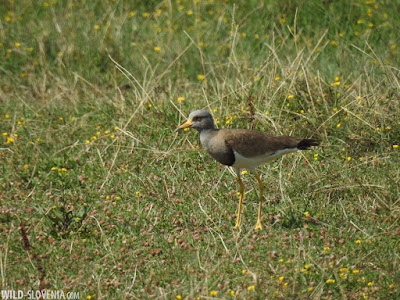Not something we usually post here, as chasing rarities is not in our nature... at least not anymore - you know, we grew up :-) However a truly exotic bird is stirring the Slovenian birding scene at the moment. Yesterday morning photos of a strange unidentified lapwing photographed at Škocjanski zatok Nature Reserve appeared on Facebook. Soon knowledgeable birders came to the conclusion that the bird in question was a Grey-headed Lapwing Vanellus cinereus, an extremely rare vagrant from the Far East, the first for Slovenia and only the 5th for the Western Palearctic! Of course we didn't happen to be on the coast at the time of the find - Domen did his weekly monitoring at Škocjanski zatok only the day before, but as the bird was discovered at his working place, it would have been unprofessional not to go and see it. Therefore we swiftly changed our family plans for the afternoon and dragged some of our relatives on a "pretty normal" birdwatching walk around Škocjanski zatok. The bird was on view from the observation point number 5, grazing on the wet meadows not far from the horses & their Cattle Egrets Bubulcus ibis. It was indeed a very unusual-looking bird for our latitudes (actually longitudes!). The species doesn't even have an official name in Slovenian and until yesterday we didn't even know it existed! Grey-headed Lapwing (yesterday baptised as "pepelasta priba" or "sivoglava priba" in Slovenian) breeds in parts of Northeastern China and Japan, wintering in Southeast Asia and South Japan. Therefore it is a rather unlikely vagrant to Europe, hence the very few records for the Western Palearctic so far. Some say that records from Sweden and the Netherlands have probably involved the same bird, therefore this might be only the 3rd individual Grey-headed Lapwing to have reached the Western Palearctic!
Today the bird was still there in the same area and around 15 twitchers must have come to see it - this is a lot for Slovenian standards! Given its rarity, the species obviously represents a strong drag for birders/twitchers from surrounding countries and more visitors are expected over the weekend. Fingers crossed the bird will stay here for more admirers to enjoy.




